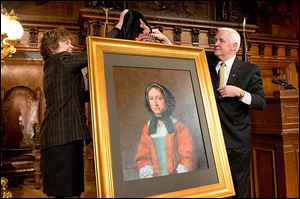
Portrait to honor Pa. leader Hannah Penn
Painting will hang in governor’s office
3/24/2014
Gov. Tom Corbett and First Lady Susan Corbett unveil a portrait of Hannah Callowhill Penn on Sunday. It will be displayed among portraits of Pennsylvania’s founders and former governors, which include her husband, William Penn.
HARRISBURG — It took a woman to clear Pennsylvania’s debts.
And settle that boundary dispute with Maryland. And confirm land purchases from the native peoples.
Three hundred years ago, his colony saddled with financial and political challenges, William Penn suffered an incapacitating stroke. His wife, Hannah Callowhill Penn, took charge, overseeing Pennsylvania for six years until his death and then for another eight.
Soon, her portrait will join those of her husband, her deputy governor, William Keith, and other Pennsylvania governors in a series of paintings that line the walls of Pennsylvania Gov. Tom Corbett’s offices.
The idea of honoring Hannah Penn grew out of a casual conversation between the president of the Historical Society of Pennsylvania and the state’s first lady, Susan Corbett, who related that young women at the start of Mr. Corbett’s term asked how someone could become first lady.
When Mrs. Corbett said they might better try to become the first female governor of Pennsylvania, Kim Sajet, who now directs the National Portrait Gallery, told her about Hannah Penn.
Last week, the Corbetts unveiled the newly finished portrait, paid for with private donations. The artist, Ellen Cooper of Media, Pa., had examined a chalk drawing made during Hannah Penn’s life and toured Pennsbury Manor, where she lived during her brief time in Pennsylvania, years before she managed the colony through correspondence from England. Ms. Cooper even tried on the many layers of clothing she would have worn.
“Having lived in an age before photography, with no person-to-person account of her, I didn’t have much to go on,” Ms. Cooper said of the portrait. ‘‘There is one chalk drawing of Hannah by Francis Place that was apparently done from life, the exact date unknown. I was able to see that drawing and the drawing of William Penn in the vaults of the Historical Society of Pennsylvania.
“She’s very pale in that drawing, and it’s not very detailed, and it looks like the artist endeavored to paint her matter-of-factly, instead of a flattering approach.’’ Ms. Cooper said. ‘‘... But that’s what I based my painting on because that artist saw her and drew her likeness. My job was to do an interpretation of Hannah in oil to go with the portraits of the other governors in the governor’s office.
“I don’t know how Hannah had time to do what she did — with a husband ill, with a colony on the other side of the ocean to oversee, with lawsuits and boundary disputes, with financial concerns to make right, with seven children of her own and three stepchildren, with the household duties of a woman and with her own illness, not to mention no electricity, no running water,” Ms. Cooper said at the portrait’s unveiling.
Born in Bristol, England, in 1671, Hannah Callowhill married William Penn on March 5, 1696, when she was 25 and he was 52.
As a Quaker, a denomination that believed in the equality of women, and an only surviving child, whose prosperous father recognized her as his heir, Hannah had been educated in commerce and accounting, as well as in social obligations.
“She learned how to run a business and manage people,” Ms. Sajet said. “And this is in fact what saved Pennsylvania.”
A financial crisis had persuaded William Penn to try to sell his colony back to the crown. Disagreement about the boundary between Pennsylvania and Maryland made it harder to collect quitrents, a form of tax, from settlers in the contested territory, said Douglas Miller, historic site administrator of Pennsbury Manor. There was a dispute with a creditor.
After years of negotiation, Mrs. Penn reached agreement with Lord Baltimore on the disputed territory, a success that won her the respect of the residents, according to a 2003 article by William Kashatus in Pennsylvania Heritage magazine. She succeeded in upholding good relations with the native peoples, and she fought back a challenge to her authority by William’s son by his first marriage, who was described at the unveiling as “a bit of a dissolute.”
“One of those leaders who has kind of been in the back pages of history, that you couldn’t find, was Hannah Penn,” Mr. Corbett said at the unveiling.
To further recognize her, the Pennsylvania Department of Education has published lesson plans about Hannah Penn for teachers to use in grades 3-5 and 9-12.
“At the time when Hannah was doing this, the only other woman who had more responsibility in terms of acreage and number of people would have been the queen of England, Queen Anne,” Mr. Miller said.
Mrs. Penn’s portrait will hang in the governor’s reception room, where the public can see it, until the summer, when it will join the others in the governor’s offices.
The Block News Alliance consists of The Blade and the Pittsburgh Post-Gazette. Karen Langley is a reporter for the Post-Gazette.
Contact Karen Langley at: klangley@post-gazette.com, 717-787-2141, or on Twitter @karen_langley.